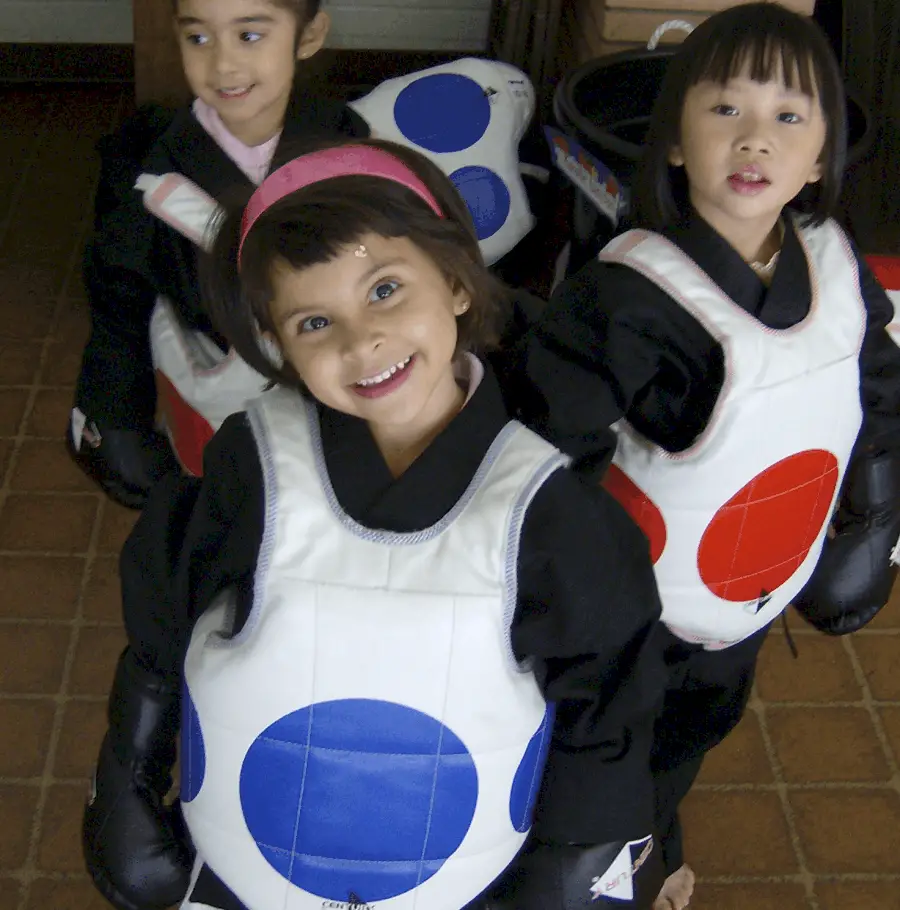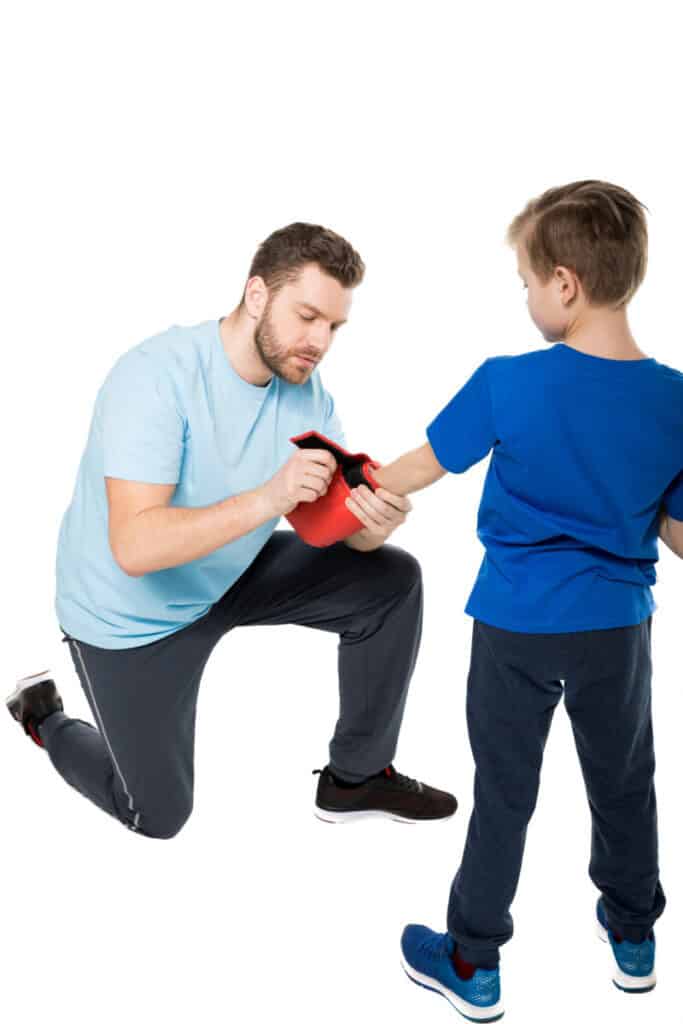
Sparring in martial arts is a great way to keep children active and productively use their energy; they can practice self-defense, stay physically fit, and grow their confidence as they improve their skills. However, some parents may have concerns about the safety of their kids as they spar with others.
In order to make kids sparring a safer experience, kids must be evaluated for proficiency, the right gear must be used, an open appropriate space must be maintained, kids must be equally matched, and parents must have realistic expectations and show restraint.
Below, we’ll cover five things you should know about martial arts sparring to ensure your child stays safe during the activity, from recognizing the proper equipment that should be used to how you can identify a safe—or unsafe—sparring environment.
Contents
One-on-One Training and Assessments Help

Although it may seem like a waste of money to invest in one-on-one training sessions for your child with their instructor, it can make a huge difference when it comes to their sparring safety, especially if they’re new to the activity.
For example, during your child’s initial one-on-one class, the instructor may go through an assessment to see if they are ready to participate in a particular martial art or spar with others; this may include identifying things like:
- Past and current injuries and other health conditions
- Athletic abilities
- Emotional maturity
- Age
Being informed of where your kid falls in these categories will give a new instructor a better idea of how prepared they really are to practice a martial art with other children. Without knowing these things, there is a much greater possibility of running the risk of a new injury or disengaging the child because a particular program isn’t right for them.
To learn more about Karate And Taekwondo for kids see my article here: Karate vs Taekwondo: Is One Better Or Just Better For You?
Past and Current Injuries
The first question any martial arts instructor should be asking is what type of injuries the child has suffered from or any underlying conditions or health issues they should know about. For instance, if a child has broken their arm two times already before the age of six, they may suggest that they consider a different path of martial arts to allow the body to develop more.
Another thing a trainer will consider is any medical illnesses. For example, it’s critical to know if the child has diabetes or even a mental disorder that would affect their practice or how they can interact with other kids in a group class or while sparring.
Athletic Abilities

Knowing how physically fit your child is will give the trainer a sense of how much they can push them during sparring. After all, each kid is different: for example, a child trying out a sport for the first time will not be able to handle the same physical stress that comes with martial arts and sparring as a kid who has played soccer for two years.
An instructor will learn more about your child’s experience with martial arts and any sports they might have participated in; this will give them an idea of what type of exercise your kid is accustomed to and whether the physical skills used in other activities can safely be applied to the martial art and sparring.
However, because it’s certainly possible that a kid can be good at one sport but very unathletic in another, the teacher may also ask your child to demonstrate their form while running, jumping, or other exercises that may be used in sparring or class.
This will also indicate how quickly your kid may be able to adapt to and learn the martial art so the instructor can develop a progressive training schedule for them and determine whether they are fit to join a group class, spar with other children, or require additional one-on-one training.
Emotional Maturity
Many times per week kids are in competition with one another. This happens in games, contests at school, and even in their social circles sometimes on a daily basis. This type of competition is healthy and productive as long as the child is mentally prepared for it.
We have all seen the toddler that only wants to play if they win. We have also all seen the third grader that hasn’t moved past that emotional hurdle. This can be a real problem for some children. If they are emotionally delayed or their maturity level is lagging in some way, competition in the martial arts whether grappling or striking may need to wait.
This should be assessed by the instructor after an extended period of training, with help from input from parents. I have even come across teenagers that could not handle losing or not performing in reality the way they imagined it in their minds. Honestly, I have met a couple of adults like this.
In a study published in Recent Research in Science and Technology, findings declare “that the emotional maturity of college students is extremely unstable.” Even at the level of undergraduate studies at the university level, a sizable number of these students are not emotionally stable enough to undergo intense competition. Some are, but some are not.
Before any sparring activity is attempted, young and older students alike need to be evaluated to see if they can emotionally handle the drill. If a child is prone to emotional outbursts when things don’t go their way, they could escalate the situation and become a danger to their partners and themselves.
Age
This issue flows right from the previous situation with emotional maturity. Younger children should be allowed to do live training, but it should be in a play or game style exercise. As children grow and are more physically able to control themselves and protect themselves rules can be loosened.
When children are young, it is important to stress that Karate, Judo, Kali, BJJ etc. are only for martial arts class. Once the student matures and can physically and emotionally handle training at home, with parents, or even with friends should sparring become an option.
For the younger ages, it is difficult to separate sparring, fighting, and self defense. A qualified instructor, with the help of parents can make determinations on how much live training a younger child should attempt. In my experience, it should be limited to rough-housing with dad or a favorite stuffed animal in preschool and lower elementary age groups.
It is simply unnecessary to push this sort of drill on a mind and body that is too underdeveloped to handle it. This may lead to a decline in interest at the least and serious emotional and physical harm at the worst.
The Right Sparring Gear Offers Protection
For your kid to spar safely, several pieces of safety equipment should be worn, regardless of how experienced they are in the martial art; this is especially important for younger children who are still learning to control their movements while sparring.
- Headgear: Heads up! Your child should always wear some type of headgear to protect them from a blow to the head or a fall to the ground. This is true for most all styles that have live training where hand or leg strikes are allowed. This is true whether or not head strikes are used.
- Mouthguard: It’s also in your child’s best interest to have a mouthguard in case they get hit near the teeth.
- Sparring Gloves: A set of gloves can protect your kid’s hands from injury and keep them comfortable as they make contact with the other child while sparring. Additionally, sparring gloves will soften any blows, ensuring the other child is protected from severe injury as well.
- Sparring Shoes: Sparring shoes will protect your child’s feet in the same way as sparring gloves will their hands. This is also a double protection for his or her partner, which should also be ‘padded up’.
- Shin and Forearm Guards: These padded guards will further protect your child from swings and kicks from the other kid while sparring.
- Chest or Rib Guards: Although these specific pieces of equipment are not required to use while sparring in some styles, in others they are mandatory. It doesn’t hurt to have them to keep your kid as safe as possible and most instructors will always allow extra padding.
- Athletic Cup: It is also recommended that boys wear protective athletic cups while sparring. This is for obvious reasons, even though mentioning it to them will likely bring on a wave of giggles.
All the sparring gear listed above can be purchased for a reasonable price using the Amazon affiliate links; however, you may want to check with your child’s instructor first to make sure you’re getting the best option for your child.
Another option is to visit my Little Ninja Shop. It has all you will need and a plethora of options from the highest quality manufacturers. When safety matters, having the right well made gear is essential.
Facilities Should Maintain a Safe Sparring Environment
Of course, kids will only stay safe during sparring if the environment they’re in helps accommodate this. There are several things a martial arts training facility should have to make sure this is possible, from proper safety equipment like high quality floor mats to attentive instructors who discourage roughhousing or competitiveness among students.
You can even bring inexpensive versions of these mats into your home. There are very good interlocking style mats that you can have delivered right to your door from Amazon. Here is what I use at my house at this link to Amazon.
How to Tell a Sparring Environment Isn’t Safe
The following are a few red flags you should look out for to ensure your child isn’t sparring in an unsafe environment:

Frequent Bumps and Bruises
It’s natural for your child to get a bruise here or there when falling on the mats or making some contact with other students while sparring, but when it becomes a pattern and starts to look worse and worse, there is something wrong.
A major thing to consider here is your kid’s age and what progression stage they are in. For example, if they’re just starting with sparring, they shouldn’t be getting bruised all over. Check with the instructor to ensure they’re being matched with the right age group and experience level.
Changes in Your Child’s Behavior
If your child is suddenly lashing out or becomes emotional more than before taking martial arts classes, this is another sign that something is wrong. They may be overtraining or in an overly competitive environment that puts too much pressure on them.
If this happens, you should pay close attention in the next class and talk with their instructor to see what’s going on. You can also try talking to your child as well, but make sure it is in a calm and gentle manner, so they don’t feel like they’re in trouble or something is wrong.
Sudden Loss of Interest in Training All Together
It is not uncommon for there to be an acclamation period when live training is begun. Some kids take right to it, but others take some time to adjust to the physical and mental stresses. There is a problem though when a complete lack of interest in continuing occurs that corresponds to beginning sparring practice.
If an instructor resembles Cobra Kai instructor John Kreese from The Karate Kid movie series, then you could very well find this reaction. An overly militarized, demanding, or violent instructor can immediately turn off a child’s interest in the martial arts.
If you would like some great martial arts family fun and want to bring this underdog story home for your kids, get your copy of these great Karate Kid Movies today here at Amazon.
There can also be students in the class that are being overly aggressive or abusive. This is a failure on the instructors part in not regulating the environment and prescreening those allowed to attempt sparring.
In these situations, it may not be that your child is not ready for the activity. It maybe be the environment, instructor, or other students.
Ensure Your Child is Sparring in the Right Progression
Once your child’s instructor has assessed their physical ability and experience with the martial art, they should start them with progression training. Progression training involves having your kid practice martial arts according to the appropriate difficulty level they can handle at that time, be it beginner, intermediate, or advanced classes.
As you might expect, beginner classes will usually be less intense, with no sparring sessions at all. The goal of these classes is to introduce your child to the art and help them learn the basics, such as how to move, various self-defense methods, and more.
The instructor will also consider your child’s age before choosing which level they fit in with best; this is often the case with many styles of martial arts classes. Age plays a factor in how teachers generally match students for sparring. For example, a young student just starting a class should never be placed in an advanced group with older students.
As a parent, knowing the progressions you should expect with martial arts and communicating with your child’s instructor to see how they’re doing in class regularly is critical to make sure they’re practicing at the right difficulty level.
Beginner Classes (Progression Level 1)
This first level is meant for beginners new to sparring. The things learned in class are related to basic training and eases children into becoming more active, and may include:
- On-Spot Basic Technique: This means that your child won’t be moving around and trying to do multiple things at once; this is composed of isolated drills where the focus may either just be on the upper or lower body rather than the whole.
- Improved Fitness: This class component will introduce students to regular fitness, gradually increasing the level of activity as they learn to spar.
- Footwork: Footwork drills are an essential part of learning martial arts for any beginner; it serves to introduce how to move the lower body.
- Target Practice: Instead of learning how to spar with someone else, it is safer for kids to start with shield target practice because, at this point, they do not know their own power or strength or how to control it. It is only with experience does someone learn to spar with control.
Intermediate Classes (Progression Level 2)
After your child has a good understanding of the basics, equipment and light contact and sparring drills can be introduced.
- Equipment: At first, there can seem like a lot of equipment your kid needs to wear, which may make them feel bogged down. It just takes some time to get used to and requires a little extra athletic ability to move with it. However, it’s also essential to make sure it all fits properly and does the job of keeping your kid safe too.
- Light Drills and Sparring: With the right footwork and sparring technique established, students can now participate in more sparring drills. The instructor must be heavily involved at this stage as contact with other students will be introduced for the first time.
- “Pulling” Punches and Kicks: In many forms of martial arts, students are only allowed to perform light contact during sparring. Here, kids learn to “pull” punches and kicks back after making contact, while instructors stress that full contact is only allowed in a real self-defense situation.
Advanced Classes (Progression Level 3)
This third level combines everything that has been previously mentioned, but kids will now be moving towards more advanced sparring; this is when light to medium contact can be introduced along with the added footwork and sparring drills while further increasing fitness levels.
You’ll find that adults and older kids mostly participate in these classes. Younger children cannot easily reach this difficulty level even with the right guidance from their instructor. Maintaining the proper technique, and following key sparring rules at these young ages pose many more problems than any supposed benefits.
As long as you continue to monitor your kid’s progress and know how to tell when the advanced class is becoming too much for them to handle, sparring usually won’t pose a safety issue, especially with the other safety precautions mentioned above in place.
Parent Behavior Affects Kids’ Sparring Safety Too
That’s right: your behavior can affect your child’s safety and other kids they spar with too. There are a couple of reasons why this can be the case.
For one, if you are usually not paying attention to your child’s classes and don’t communicate with their instructor often about their progress, there’s no way for you to understand what happened if something goes wrong or if your kid ends up injured. There may have been something you could have picked up on by watching at least portions of the class or speaking with the teacher that could have prevented an incident.
On the other hand, if you are always too involved or often pressure your child to be at their best or encourage them to “fight” competitively, they may wear themselves out or spar more aggressively to try to win just to appease you.
The following tips are recommended if you want to avoid these behaviors to ensure that your kid is sparring safely during class:

Check-In with Your Child
Always ask your child how they’re doing, especially if you find that you don’t have a lot of time dedicated to watching them during class. You are encouraged to ask questions like:
- Did you have fun?
- What did you learn today?
- How was your instructor today?
- Who did you spar with (for older children)?
- Do you want me to watch your next class?
The answers to these specific questions should be enough to tell you how your kid feels about their classes and your current level of involvement, and provide basic information about the teachers and students they interact with.
On the other hand, you should never ask your child the following questions:
- How did you do in sparring?
- Who did you beat today?
- Do I need to start coming to see what you’re doing?
The goal of asking your child questions should be to learn about what they are doing in class—not discouraging or intimidating them, especially if they haven’t been doing so well in class. If you make everything about the results, your kid may feel too pressured to do well during sparring, which can lead to anxiety and—in worst cases—depression.
A final note about checking in with your child: only ask questions about their class on the car ride home or soon after the session is over.
Avoid bringing up the subject when you’ve been at home for a long time or out of the blue; this is so your kid has time to take a mental and physical break from the activity (effectively avoiding burnout) and use that energy to focus on other important tasks, like schoolwork and spending time with family.
Attend Sparring Sessions on Occasion
Every once in a while if your child is of sparring age and maturity, drop in early to catch the end of a sparring session. Or better yet, if you have the time, stay for an entire class.
This shows support and encouragement to your child and gives you peace of mind that things are being run smoothly. If you notice something is unsafe, like there’s a lack of equipment, you can discreetly pull an instructor to the side to address your concerns.
Communicate with Other Parents
Communicating with other members of the training group who also have children old enough to participate in sparring can be incredibly beneficial. Sometimes, other parents may have useful feedback or recent experiences that may make you feel informed.
For example, other parents with kids that have attended martial arts classes for a long time will likely know the instructor well enough to let you know about any red flags they have noticed, such as aggressive coaching or a lack of protective gear. This kind of insight can be beneficial for preventing unwanted situations such as sparring injuries.
Best of all: Rough Around With Your Child
For dads and moms, martial arts training is an amazing opportunity to connect with your kids. This will definitely apply to younger kids, but can also be a way to get them ready for live training and sparring.
Kids love to wrestle which helps with Judo and Brazilian Jiu Jitsu. They love to play tag and ‘take out’ the bad guys in an energetic round of ‘I’m gonna steal your toys’. These are all times to teach them control and emotion management. Not to mention, you can build memories that last a lifetime.
As kids get older this may not be an option, but holding pads, heavy bags, or videoing practice so they can judge their form is. Getting involved in some way in your child’s lifelong journey in the martial arts is good for everyone involved.
In Summary
Although martial arts involve a lot of physical activity that can put your child at risk of injury, there are several things you and your child’s instructor can do to prevent these incidents from occurring.
If your kid is new to martial arts, consider enrolling them in a one-on-one class with an experienced instructor to get an idea of whether they’re ready to handle the type of physical stress the sport has. From there, the teacher will determine which difficulty, or level of progression training, they can safely pursue.
These types of classes can even be done online with a series of live sessions with a veteran instructor. An experienced teacher only needs a few sessions to give an evaluation of whether or not a child is ready for live sparring.
If you are interested in having me assess your child contact me through my contact page, and I would be happy to help and answer any questions you may have in a live online session. I also give private online classes as well as group online classes for younger kids.
Outside of that, make sure your kid has the right safety gear available when they are ready to spar to guarantee their protection. The training facility or you in your home for online classes should also have a few pieces of safety equipment, such as floor mats, to aid in this.

Finally, as a parent, remember that you should always aim to be your child’s cheerleader during classes and tournaments. Avoid putting too much pressure on them, and quietly discuss any safety concerns you have with their instructor.
